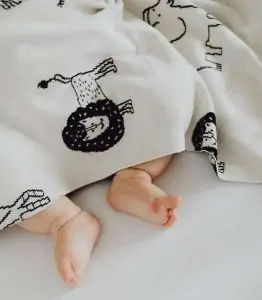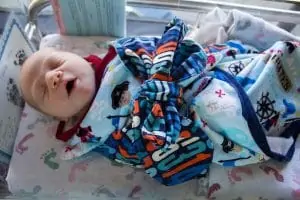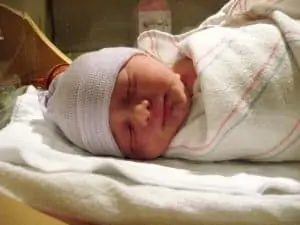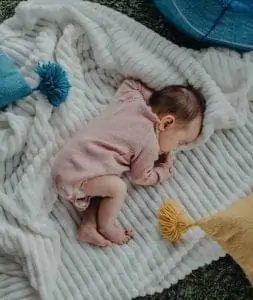Did you stand in the baby aisle at the store with a swaddle blanket in one hand and a sleep sack in the other? They help your baby sleep, so what’s the difference between a sleep sack and a swaddle?
A swaddle blanket is one of the most recognizable baby products. We all see pictures of new babies wrapped in a cocoon-looking blanket at the hospital. That’s a swaddling blanket, and their roots trace back centuries when parents realized babies love to be snug and cozy.
Modern parents have more options than just swaddle blankets, including sleep sacks, but what is a sleep sack? How is it different than a swaddle?
You want to make the right choice for your baby; I understand. Keep reading to discover the differences between a sleepsack and a swaddle blanket.
What are Swaddling Blankets?
A swaddle is a thin blanket that parents use to wrap their babies up. The idea behind swaddling is that it reminds your infant of being in the womb, where everything feels cozy and warm. Keeping your baby snug also helps to stop your baby from waking up throughout the night due to the Moro (or startle) reflex.
Never heard of the Moro reflex?
If you see your baby twitch or jerk while throwing his hands in the air, that’s the startle reflex. While all infant reflexes have important purposes behind them, this one tends to wake our babies up in the middle of the night. Our ancestors realized that swaddling reduces this reflex, helping your baby sleep longer and more soundly.
Are Swaddles Better for Newborns?
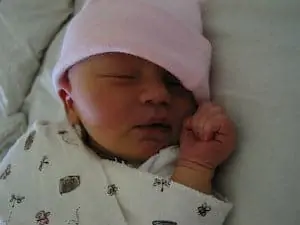
A swaddle blanket is a classic choice for newborns; babies love swaddle blankets. The key is learning how to swaddle your baby snuggly properly. When done correctly, your baby will sleep soundly; the snugness reminds them of the womb.
Here are some excellent safe swaddling tips.
When Should You Stop Using Swaddles?
Swaddles must be stopped when your baby starts to roll over. That age varies widely; some babies start to roll as early as eight weeks old. Others might not roll over until they’re four months old. It’s the parent’s job to closely watch their child and remove the swaddle before their child rolls over to prevent an accident.
Remember that:
Swaddles must be stopped earlier than sleep sacks due to the risk of suffocation. The risk is real, so don’t try to swaddle your baby after he starts to roll over. It’s too dangerous.
How Many Swaddle Blankets Do I Need?
How many swaddle blankets you need depends on how often you want to do laundry! No one wants to do laundry, though.
The best recommendation is that you have six swaddle blankets. Minimalist parents might select only four swaddle blankets, and parents who hate to do laundry might want 12.
What is a Sleep Sack?
A sleep sack is a wearable blanket that might have features that let parents use it as a swaddle. Most sleep sacks keep your baby’s hands and arms free while keeping your baby’s torso, legs, and feet inside the sack.
Some hybrid models of sleep sacks allow for swaddles. They have flaps that wrap your child’s arms, restricting movement but leaving their feet less restricted than a traditional swaddle.
This is important:

Many parents use a newborn sleep sack because the American Academy of Pediatrics changed its recommendation and told parents to remove all blankets from a baby’s crib. Blankets dramatically increase the risk of SIDs, so a sleep sack is a safer alternative. Your baby stays cozy and warm without any troubles.
Are Sleep Sacks Safe for Newborns?
Yes, sleep sacks are safe for newborns. Your baby is zipped into the sack, enclosing his legs and torso but leaving his arms and hands free to move around. Using a sleep sack eliminates parents’ worry that their baby is cold since blankets are no longer recommended.
Are Sleep Sacks Better Than Swaddles?
Sleep sacks are better than swaddles for older infants and toddlers because swaddling is unsafe after your baby rolls over. For newborns, swaddling blankets offer the snugness that most babies prefer; sleep sacks feel too open and don’t restrict the Moro reflex.
When Should You Stop Using Sleep Sacks?
Sleep sacks are safe to use until your child phases out of the sizes. Some brands offer sleep sacks up to 3T or 4T! So, your child might use these for years to come. When it comes to a sleep sack vs. swaddles, sleep sacks have a longer lifespan.
How Many Sleep Sacks Do I Need?
Sleep sacks are only used at bedtime and naptime, so you only need to have two for each size. However, something else to consider is that they come in different fabrics; some are thicker for winter weather. Many parents opt to have sleep sacks for the summer and ones for the winter.
That means you’ll need to have two for each season.
What’s The Difference: Sleep Sack vs. Swaddle Blankets?
A swaddle blanket wraps the entire baby, restricting movements of the arms and legs. A sleep sack is a shaped blanket around your baby, freeing his arms rather than limiting them.
Putting on a sleep sack is like putting on a nightgown for a baby but with a closed bottom. Some sleepsacks have armholes, while others have sleeves. Using a swaddle blanket takes more effort and time to use, especially in the middle of the night when you’re exhausted.
Another difference is that swaddles are only for newborns and infants until they start to roll over independently. That might be as soon as eight weeks old for some infants. Swaddles restrict your baby’s limb movements, so if they accidentally roll over while swaddled, it drastically increases the risk of suffocation.
On the other hand, sleep sacks are safe to use until your child is a toddler. Babies and toddlers move their arms freely while keeping their legs confined. Toddlers even stand up in a sleep sack so suffocation does not occur.
The Best Baby Swaddles
UpSimples Baby Swaddle Blanket
UpSimples create a bamboo and muslin cotton blend swaddle blanket. This cozy fabric is perfect for babies; it keeps them warm while reducing the risk of overheating and is gentle on sensitive skin. The blankets measure 46” x 45”.
LifeTree Solid Swaddle Blankets
LifeTree sells swaddle blankets of 70% bamboo and 30% cotton, measuring 47” x 47”. They offer their blankets its solid themes of earthy color tones, perfect for a boy or a girl. This blend of bamboo and muslin cotton makes them incredibly soft, breathable, and gentle on sensitive skin.
Aden & Anais were one of the founders of the muslin swaddle blankets. They made muslin popular, offering some of the best swaddling blankets on the market. These blankets measure 47” x 47”, and dozens of patterns are available.
The Best Baby Sleep Sacks
Halo Sleepsack Cotton Wearable Blanket
Halo created the original wearable blanket, so you know their product is trustworthy. These are made with 100% cotton interlock fabric with a TOG rating of 0.5. It’s perfect for year-round use. Halo sells several sizes from Small to X-Large, so babies from 10 to 36lbs can use these sacks.
Burt’s Bees Baby Wearable Blanket
Burt’s Bees uses 100% cotton to create their wearable blankets. There is a zipper open at the bottom for easy diaper changes in the middle of the night and an interior zipper guard to stop it from harming your baby. The material has a 0.5 TOG rating, perfect for year-round use. Burt’s Bees uses GOTS-certified, 100% organic cotton for their sleep sacks.
Nested Bean Zen Sack – Gently Weight Sleep Sack
Nested Bean creates a 100% cotton sleep sack with a gentle weight on the chest region that mimics the pressure of a parent’s hand. These sleep sacks help babies sleep longer. They’re made for all babies with sizes up to 24 months. The TOG rating is 0.5, perfect for year-round comfort; it’s not too hot or cold.
When to Transition Baby from Swaddle to Sleep Sack
Babies need to transition from a swaddle to a sleep sack when they roll over from back to tummy. If possible, it’s best to bring the transition BEFORE your baby rolls over. At that point, the swaddle must be removed immediately, but cold turkey your baby away from the swaddle isn’t the right way to go.
Babies need time to adjust. So, start the transition when your baby is 8-12 weeks old. That way, when your baby starts to roll over, you’re almost completed with the transition.
How to Transition Baby from Swaddle to Sleep Sack
Ensure you take time when transitioning your baby from a swaddle to a sleep sack. Here’s what you need to do.
- Start by swaddling with one arm out. It’s not as challenging as it sounds and gives your baby a feeling of freedom while still enjoying the snugness and coziness of a swaddle.
- Swaddle with both arms out. This is a big step, and it will take your baby time to adjust. Keep the swaddle around his torso and legs, but the arm movement and lack of snugness will cause sleeping problems for several days until your baby is ready to move on to the next step.
- Try napping without any swaddling. Naptimes are a time when babies adjust easier than bedtime.
- Introduce the sleep sack at naptimes, and after several days, use it at night, replacing the swaddle entirely.
Make sure you go slow for your baby. It’s hard for babies to adjust; they love swaddling and how it makes them feel. After a few weeks, your baby will sleep well without a swaddle.
Final Thoughts
Remember that swaddle blankets offer the cozy feeling that newborns love but have a limited lifespan regarding the difference between a sleep sack and a swaddle blanket. Leave the sleep sacks for the months after your baby is no longer swaddled. That way, you have the best of both worlds.
Hey, this is Linda. My biggest accomplishment in life is being a mother of four children. Their current ages range from almost ten years old down to 20 months old.
I’m passionate about writing parenting articles because I understand so well all of the problems and trials you face as a parent. From breastfeeding woes to budgeting problems and behavior problems, along with everything in between, chances are I’ve faced it over the last ten years. Read more about Linda here.

